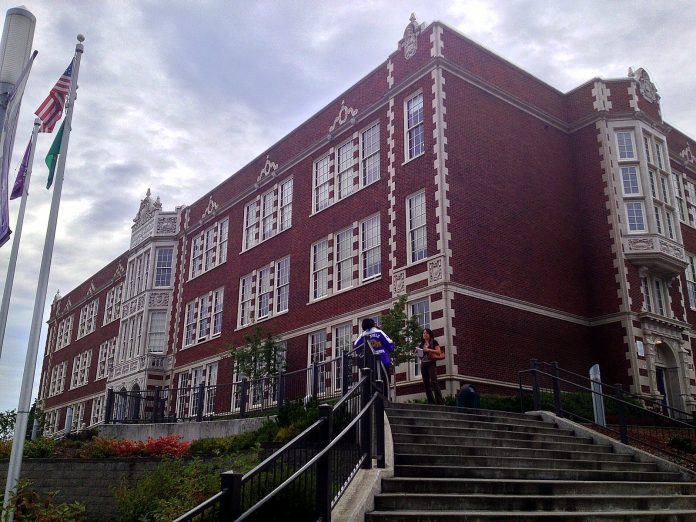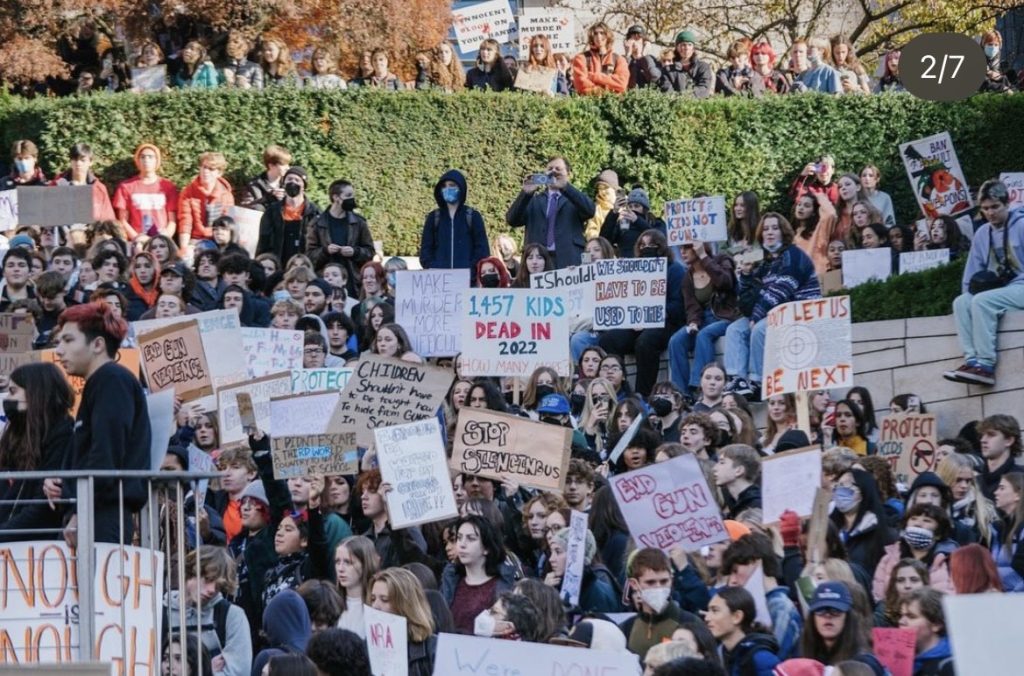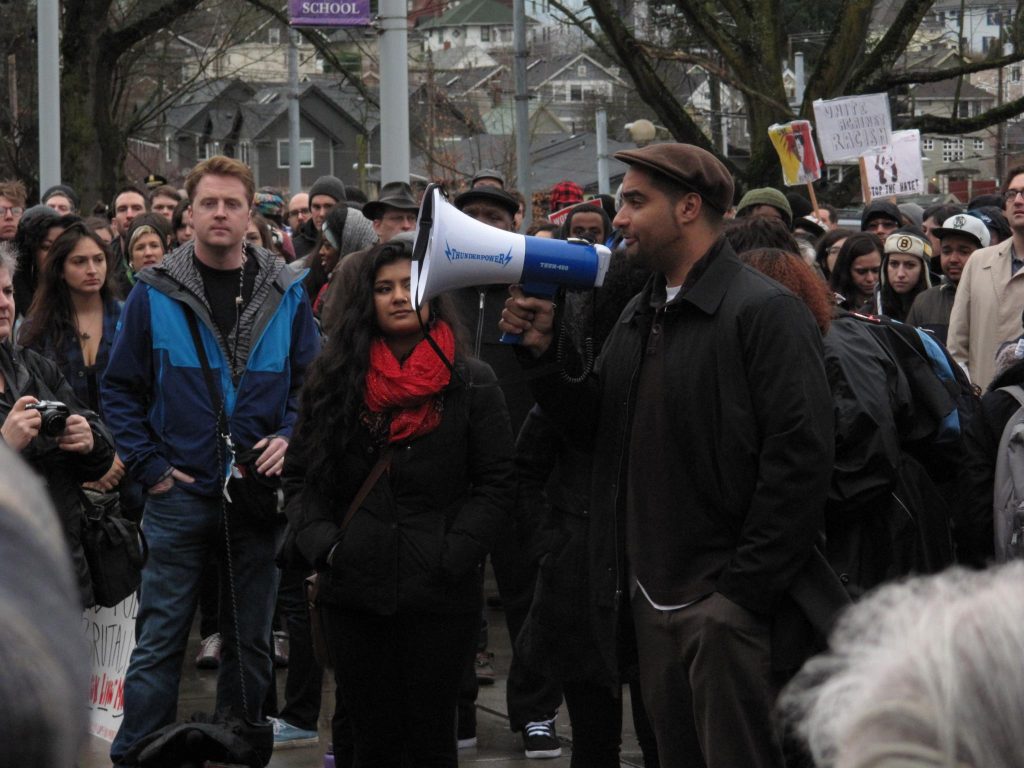
Gun violence has recently been taking a heavy toll on Seattle youth. On June 6, a 17-year-old Garfield student Amarr Murphy-Paine was killed in a shooting at Garfield High School. Another 17-year-old student was shot in the leg at a bus stop across from Garfield High School in March. In January, a 15-year-old student was killed in a shooting at the Teen Life Center next to Chief Sealth High School. In 2023, a 19-year-old suffered gunshot wounds at Garfield’s Teen Life Center parking lot, and in November of 2022, a 17-year-old student was shot and killed at Ingraham High School.
Mayor Bruce Harrell’s recent executive order addressing gun violence in schools lays out these stark facts, which don’t include two other recent deaths of teenagers by gun violence in the region, an 18-year-old student in a parking lot next to Kent-Meridian High School, and a 17-year-old from Kent-Meridian at a Big 5 Sporting Goods store.
Murphy-Paine’s death raised an outcry from the surrounding community, including a vigil, a silent march, a unity walk, and a “We are Here and We Care” event the morning students returned to school. Mourners have demanded action to curb the violence and ensure a safe learning environment at local schools.
While Seattle’s homicide numbers have fallen in the first five months of 2024, with 16 recorded versus 25 during the same period in 2023, shootings and shots fired have risen 8% year-to-date versus 2023.
100 Days of Action
Recent events prompted King County Executive Dow Constantine to announce “100 Days of Action” against gun violence in his recent state of the county address. He has asked the relatively new King County Regional Office of Gun Violence Prevention, part of the Public Health Department, to coordinate this work in collaboration with regional and community partners, including the City of Seattle.
In his address, Constantine referenced a recent meeting about gun violence at the White House, where several jurisdictions reported “seeing positive results from short, intensive violence prevention campaigns.”
The Office of Gun Violence Prevention and its partners are still lining up the details of the County’s 100-day campaign, but said they’d be announced later this summer.
Community outcry continues
Meanwhile, community members are deeply concerned about the continuing gun violence in and around Seattle schools, and some have been questioning the efficacy of both the city and the school board.
“Seattle Public Schools and the City of Seattle have done nothing to prevent the shootings and the death of Ammar Murphy Paine that occurred on campus at Garfield High School on Thursday,” parent Melanie Skinner said at a recent Seattle public safety committee meeting. “Garfield has been in shelter-in-place [orders] six times this year, and that combined with the other most recent shooting of a Garfield student on March 13 is too much to bear for kids, teachers, and administrators.”
“The apathy and the ineffectiveness of the City of Seattle, Mayor Harrell, and Seattle Public Schools have overridden any meaningful and concrete changes,” Skinner continued. “There have been a multitude of meetings and public forums regarding safety but nothing impactful comes from these. And what is even more maddening is that there is no sense of urgency.”
Seattle Student Union’s Executive Board Director Natalya McConnell agreed: “On a city level, the mayor can improve the mental health of students across the district. So it’s disappointing that he has the power to do something, but he refuses to.”
She referenced the $20 million for student mental health won by students last fall for this year’s budget, paid for by a slight increase in the JumpStart payroll tax. Companies have been paying the increased tax rate this year, but the $20 million has yet to be allocated and spent. And because of laws regulating the way the JumpStart tax can be used, the city council will need to take legislative action for these dollars to be spent on student mental health.
Notably, Budget Chair Dan Strauss did not vote in favor of the 0.1% JumpStart tax increase to raise funds for student mental health last fall. “We all want more mental health counselors in schools. I haven’t found somebody who disagrees with that point of view,” Strauss said at the recent June budget meeting. But he also expressed concern at the lack of “consultation with another governmental entity to understand whether they can actually spend the money that we raise or not, and to ensure the capacity of those dollars can be spent in the ways we’re talking about.”
Councilmember Maritza Rivera agreed, saying, “There are no mental health experts at the department or at the city. There’s Public Health, but I’m not sure how plugged in Public Health is to that, so definitely a lot of questions here.”
City report on youth mental health
Harrell’s executive order is informed by a report recently completed by the city’s Innovation and Performance team. The team began their research in January, reaching out to top academics and experts in the field of youth mental health, both nationally and locally, before engaging with actual students through workshops and focus groups. They also cultivated a relationship with the school district.
“Student mental health is actually a super well-researched space,” said Leah Tivoli, the director of the Innovation and Performance team. “The consistency across experts, across the research, across everything, says that what you need is really a multi-pronged, coordinated approach.”
This approach is based on the idea of the Multi-Tiered Systems of Supports, a pyramid organizing three tiers for student instruction and intervention. The bottom level of this pyramid – Tier 1 – contains prevention practices offered to all students, such as providing students with a language for talking about mental health, enrichment programming that might include academic, social, nature, and physical activities and supports, positive and predictable routines, and safe environments.
Tier 2 of the pyramid is focused on early intervention, providing more targeted supports for students identified as being at risk, such as mentoring, skill development, learning in affinity groups, and brief interventions that might be offered by academic counselors or school-based health centers.
The top level of the pyramid – Tier 3 – consists of the most intensive supports like talk therapy. Based on Seattle Public Schools (SPS) screening data, around 10% of student populations fall into the category that needs more intensive supports, which equates to around 3,000 teenage students.
“I really don’t think that the mental health system is designed for youth,” Tivoli said. “What really came out of this for me is the importance of service design and designing these systems for the people who are supposed to be benefiting from them.”
Tivoli spoke of the difficulty of making sure students are aware of the services already on offer and how they can be more easily connected to the appropriate services, as well as the importance of routine screening so kids don’t fall through the cracks.
The report makes five recommendations of investment strategies for student mental health:
- Improving awareness and access to existing resources;
- Expanding mental health education, destigmatization, and training;
- Expanding enrichment programs that address the nature deficit;
- Implementing screening and referral in high schools; and
- Expanding access to therapy.
These recommendations are meant to address all three tiers of students’ support needs.
“Ultimately, this has to be done through partnerships,” Tivoli said. “There really isn’t one single player that’s responsible for the mental health of youth. It’s parents, it’s schools, it’s families, it’s your city. And so I think it’s really important for everyone to team up on this issue and figure it out.”
Harrell’s plan
As part of his new mental health investment strategy, Harrell has announced he will seek up to $10 million for 2024 during the mid-year supplemental budget process that will begin in July. This would include $2.4 million for initial telehealth mental health services and $2 million for violence prevention programs. The plan is for community-based organizations to be able to start making telehealth referrals this summer. Further investment in violence prevention will include existing programs such as Community Passageways and Urban Family; whether any new violence prevention programs will be created, or further much-needed investments in them or restorative justice practices be made, hasn’t yet been decided.
Harrell’s plan also includes scaling up the city’s Reach Out Seattle initiative, beginning with an awareness campaign that will promote the new state mental health hotline 988 and educate the public on early warning signs of mental health distress in youth and how to support youth who are struggling. The campaign aims to destigmatize conversations around mental health. His office is also looking into installing CCTV cameras around Garfield and the surrounding area, although research shows CCTV is not particularly effective at deterring gun violence.
Harrell also continues to be adamant in advocating for changes to state law to give cities greater power to institute gun control laws at a local level.
However, Harrell remained noncommittal to spending the remaining $10 million raised by the JumpStart tax increase on mental health support as planned, and a spokesperson said the mayor is still considering how the funding should be spent.
“It is not feasible for the City to stand up a $20 million program in the six remaining months of the year, especially as there is a national shortage of psychiatrists and mental health workers,” Harrell spokesperson Callie Craighead said.
Viewing the report conducted by the Innovation and Performance team as a kind of road map, the Mayor’s Office said the most immediate and impactful investment to improve youth mental health was expanding telehealth options.
“We are beginning with the initial $2.4 million investment to serve 2,000 students – a number determined by our research of students considered medium to high risk – with telehealth services and will look for opportunities to increase investments to improve access to enrichment programs, respond to nature deficit with outdoor programming, de-stigmatize mental health for students and families, provide early intervention training through the Reach Out Seattle initiative, expand proactive screening in high schools, and increase access to therapy (telehealth and in-person),” Craighead said.
McConnell, however, remains unimpressed.“[The telehealth program is] only going to reach 2,000 students, in their own words, and it won’t reach the other approximately 40-50,000 students in Seattle Public Schools,” she said. “So Mayor Bruce Harrell should not pat himself on the back before he actually listens to students and implements the money that we already won, because he’s just giving us bread crumbs right now.”
The School Resource Officer debate returns
Amidst the conversation about student mental health, some community members have begun to ask if school resource officers (SROs), removed from SPS in 2020 in the wake of the George Floyd protests, should return. The decision lies in the hands of the Seattle School Board.

The Garfield PTSA has voted to demand the Seattle School Board restore the SRO program and place a dedicated Seattle Police Department (SPD) officer in Garfield High School when the new school year begins. Interim SPD Chief Sue Rahr is also advocating in favor of reinstating the SRO program.
SPS Superintendent Brett Jones sent a letter to parents last Friday, saying, “Community members have inquired about the return of School Emphasis Officers (SEO) or School Resources Officers (SRO) to SPS campuses. SPS staff and city officials are entering into active discussions about how SEOs and SROs could potentially fit into an ongoing program of safety improvements. This discussion assumes SPD and SPS will engage students and the community before final decisions are made.”
But not everyone agrees that reinstituting SROs in schools is a good idea. Amanda Thornewell, the parent of a former Garfield student, published an op-ed at The Stranger detailing her family’s traumatic experience with Garfield’s former SRO, who allegedly sought to intimidate and silence her son after he reported a hazing incident. Her son recently won a settlement with the school district related to this experience.
“I was part of a group that fought for the removal of cops from schools in 2020 when I was in eighth grade. And so many students in South Seattle, so many Black students in South Seattle fought for this,” McConnell said. “Police have not changed at all. They continue to kill people.”
Back in 2017, the ACLU of Washington published a blog post stating, “School policing as currently practiced in Washington — with few guidelines and scant oversight — may even make schools less safe by alienating students from school and contributing to the school to prison pipeline. Rather than investing in police, schools should prioritize counselors, mental health professionals, social workers, teacher training and evidence-based programs to improve the school climate.”

“Cops will not make our schools safer, and it’s not what the community wants, and it’s terrible,” McConnell continued. “The mayor is using this recent shooting at Garfield High School to advance his own agenda for violence.”
Recent research shows that SROs in schools might reduce certain types of violence – such as threats and physical altercations that don’t involve weapons – but they haven’t been shown to reduce shootings. Meanwhile the presence of SROs does increase suspensions, expulsions, arrests, and referrals to police, especially for students who are Black, male, and/or disabled.
In a recent episode of her podcast Hacks & Wonks, political consultant Crystal Fincher discussed the “invigoration of the conversation” around reintroducing SROs.
“What I have seen consistently happen in these situations is for people to look at – ‘Well, let’s drop a cop in here’ and that be the end of the solution,” Fincher said. “Even if they do that, there is no reality in which that is the only thing that needs to happen to make schools more safe and to reduce gun violence in and around schools. And I also notice that there’s a lot of talk about school resource officers immediately after this shooting that we did not see immediately after the Ingraham shooting. And I find that interesting and worth examining.”
McConnell was more blunt. “I think it’s pretty obvious that it’s about race. They want to police people of color. They want to police people on the South End of Seattle,” she said.
In 2020, the Seattle Times reported that all SROs in Seattle were stationed in the central and southern regions of the city, where there is a higher concentration of students of color.
Unclear trajectory
For now, the city’s response remains in limbo, and elected officials remain on the hook for an actionable plan. The city council must vote on whether to release the $10 million for student mental health, and a decision must be reached as to what to do with the remaining $10 million originally allocated for that purpose.
Harrell’s plan for the “up to $10 million” must be fleshed out and actually implemented. Whether the full $20 million will be invested in student mental health going forward into 2025 has yet to be determined, but will be a decision shared by Harrell and the council.
The Seattle School Board will have to make the decision as to whether to reintroduce SROs to Seattle’s schools.
While all these wheels turn, students will continue to be the ones who experience the consequences. McConnell doesn’t feel optimistic and says Harrell’s plan last year involving a Student Mental Health Supports pilot and youth mental health initiative has not had much of an impact.
“We have one therapist for 1,300 students, and that has not changed,” McConnell said. “The mayor hasn’t implemented the $20 million through school mental health counselors, and so until he does that, it’s going to stay the same.”
Amy Sundberg is the publisher of Notes from the Emerald City, a weekly newsletter on Seattle politics and policy with a particular focus on public safety, police accountability, and the criminal legal system. She also writes science fiction, fantasy, and horror novels. She is particularly fond of Seattle’s parks, where she can often be found walking her little dog.


